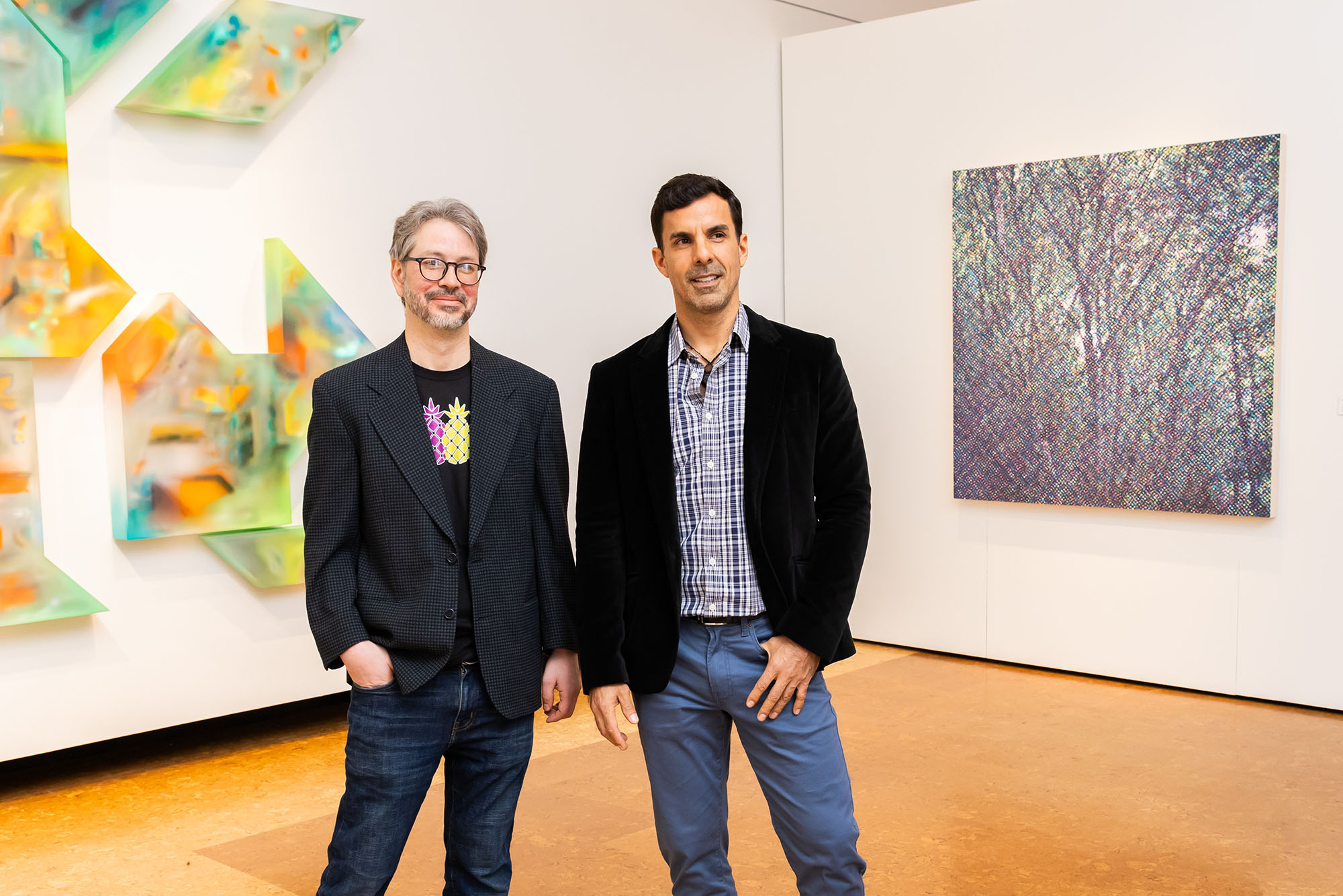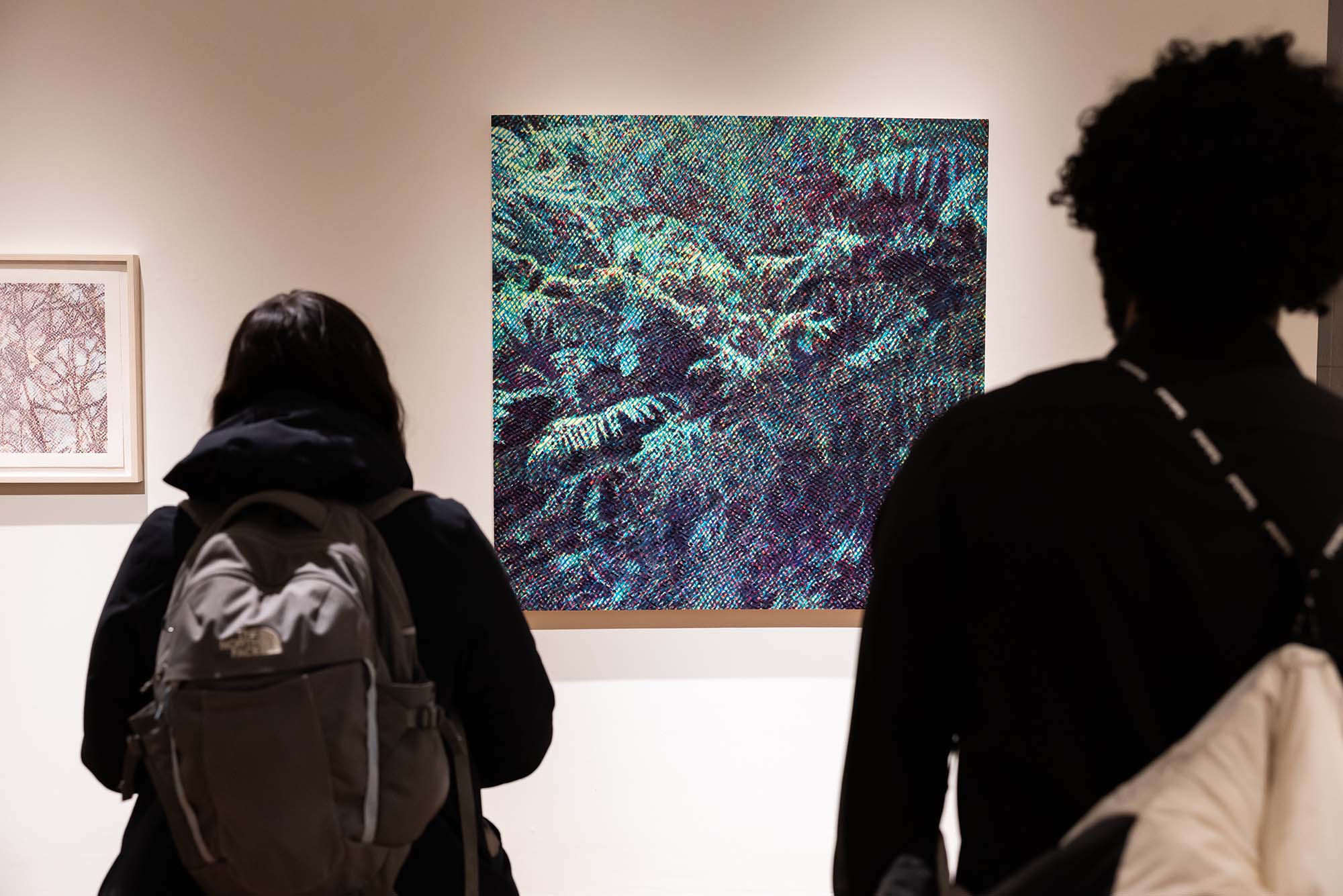Landscapes of the Natural and Manmade World Unite in New Stone Gallery Show
Work by local artists Michael Zachary and Juan José Barboza-Gubo on view through March 7

Desborde, a large-format work by Juan José Barboza-Gubo, uses a translucent acrylic medium to allow light to pass through layers of bright oil paint
Landscapes of the Natural and Manmade World Unite in New Stone Gallery Show
Work by local artists Michael Zachary and Juan José Barboza-Gubo on view through March 7
Artists Juan José Barboza-Gubo and Michael Zachary have been each other’s biggest fans for years. The two, who met in graduate school and now are both Massachusetts College of Art & Design faculty members, have long talked about having a dual exhibition.
Their ambition has finally been realized in the new show Transluz/Translucent, on view at Boston University’s Faye G., Jo, and James Stone Gallery through March 7. The show begins with a testament to their bond: two pieces of early art hang side-by-side, one by Zachary and the other by Barboza-Gubo, each proudly listed as part of the others collection. It’s the first thing the two want visitors to take note of as they begin their journey through the gallery.
Transluz/Translucent is a shared vision: throughout their careers, both artists have confronted landscapes—of the natural and man-made worlds and of the mind—with a similar balance of representation and abstraction, a shared attention to quality of light, and a desire to confront the boundaries of reality and the limitations of the naked eye.
“We were looking at each other’s work, and we thought that there was something happening between his work and mine…we thought it would be really good to show them together, or at least to have some kind of a conversation about the similar subjects,” Barboza-Gubo says. “I trust my intuition as much as possible, and I think the same goes for Michael. We were literally photographing similar things before we even started talking and doing studio visits with each other.”

Zachary and Barboza-Gubo’s decision to ground their exhibition in depictions of the natural world highlights a similarity in inspiration and approach, but each artist freely acknowledges that their technical processes are unique. While Barboza-Gubo works with large-format acrylic paintings/installations that border on the sculptural, Zachary is engaged in a technique-oriented approach that limits his color usage to the CMYK color model—cyan, magenta, yellow, and black, as is used in four-color process printing—and combines them in intricate, cross-hatched grids to create verdant green, buttery ivory, and rich copper. Like a post-Impressionist painting for the digital age, his images coalesce more clearly the farther away you stand: a heron, overgrown vines on a fence, a skein of tree branches. The closer viewers get, the more they can understand the work’s assembling parts.
“I think the line between the natural and the man-made is a lot blurrier than we think: we don’t so much look at nature as a dispassionate observer as we project our own subconscious onto it,” Zachary says. “On the other hand, there’s undeniably an otherness and a sense of awe to the natural world. My process and my subject matter is a recognition of that paradox… That’s why I use [crosshatched] lines rather than dots or marks, because dots tend to still have a bit of a figure separation, whereas lines weave everything together. You can’t tell where the systematic ends and the organic begins.”

Many of Barboza-Gubo’s works on view are the result of the artist layering bright oil paints within a thick, frosted acrylic medium, which is meant to dissolve the piece’s borders and “allow you to see the interior of the [work].” Unlike with a canvas, light is able penetrate the material he uses, creating a dimensional effect on the paints trapped within.
“I’m really interested in light, the most pure concept of light,” he says. “You have these moments of fogginess and this absence of clarity…but there is nothing hiding. Everything is open to interpretation.”
Barboza-Gubo’s largest installation, Desborde, takes up two gallery walls and consists of about 20 massive acrylic segments, each containing brilliant flashes of neon orange and yellow, deep blue, a jungle’s worth of greens. According to the artist, they were inspired by mosaic tiles he discovered in the remnants of a burned-out building in Iquitos, a city fringed by the Amazon rainforest in his native Peru.
“This building was a heritage site that caught on fire five years ago,” he explains. “It faced the Amazon River and when it caught on fire only the external structure survived. I’m using the imagery of the tiles in the building, the geometry and the structure of those tiles, how they’re literally falling apart.”

On another wall hangs a ring of sculpted, white acrylic medium, meant to evoke an ancient vine, which faces Mirror, an enigmatic canvas of Zachary’s featuring a mirror nestled in the branches of a tree, reflecting the sky.
“Both works are about cyclical time, repetition, and mirroring,” Zachary says. “Combining both works puts them in a conversation with each other that both reinforces the underlying ideas while also adding some nuance and depth to the experience.”
Similarities aside, Lissa Cramer (MET’18), director of BU Art Galleries, sees Transluz/Translucent as a fine example of two artists at the height of their creative careers, each with a coherence and clarity of vision to back up his technical prowess.
“The most significant thread between the two artists is their exceptional artistry,” Cramer says. “Both Juan and Michael demonstrate great attention to detail and are exacting in their technical skills. Their work is sharp, clean, and flawless.”

For the two friends, the exhibition is an opportunity for viewers to explore the world in new ways—but only if they’re willing to look closely—and let the power of nature take over.
“It’s a very coy show by design, and in a lot of ways we would both rather hint subtly at things in order to create a space for your imagination as a viewer, rather than be too direct,” Zachary says. “We wanted the show to feel like something absolutely familiar is happening, but just outside of your ability to understand it logically and name it, like a good line of poetry or a half-remembered dream when you wake up.”
Trasluz/Translucent: Works by Juan José Barboza-Gubo and Michael Zachary is on view at the Faye G., Jo, and James Stone Gallery, 855 Comm Ave., through March 7. The gallery is free and open to the public Tuesday through Saturday, 11 am to 5 pm.

Comments & Discussion
Boston University moderates comments to facilitate an informed, substantive, civil conversation. Abusive, profane, self-promotional, misleading, incoherent or off-topic comments will be rejected. Moderators are staffed during regular business hours (EST) and can only accept comments written in English. Statistics or facts must include a citation or a link to the citation.